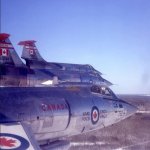bdft
CGN Ultra frequent flyer
You want, "way smaller than you ever thought", go stand beside an ME109. They are shockingly small.
Most of the WW1 aircraft were barely bigger than kites. Not much different either.
You want, "way smaller than you ever thought", go stand beside an ME109. They are shockingly small.
Pretty close

I flew in a North American B-25 Mitchell in the late 40's at Suffield Experimental Station in Alberta. I was about 5 years old.
I've mentioned it before, but my Grampa ended up as a welder for the RCAF. Spent the war in North Ontario bopping between the international training aerodromes, working on the crash crews, cutting kids (or what was left) out of their trainers when they failed their solos. Only bits and pieces of that ever came up in conversation, when he was that special kind of drunk. Decent enough fella, worked hard to put food on the table for his family, never raised a hand to his wife or my dad, drank himself to sleep every night until cancer took him in his late 70's.
....


Spotted out at KRDU General Aviation on 4-10-2010. Picture taken by Marshall Sherard KE4Z.....
Registered as Canadian C-FGAT in 2005.

Tail Number C-FGAT.
Spotted out at KRDU General Aviation on 4-10-2010. Picture taken by Marshall Sherard KE4ZNR.
Originally intended as a replacement for the Hawker Tempest, development of the Sea Fury began in 1942 for the RAF.
The Sea Fury’s maiden flight took place on February 21st, 1945. The fully-navalised Sea Fury with arrester hook and folding wings did not fly until October 21, 1945.
Due to the end of WW2, the RAF version was cancelled, however the Sea Fury for the Fleet Air Arm continued production to replace the aging wartime fighters.
The Royal Canadian Navy equipped Squadrons VF-870 and VF-871 with the Sea Fury. These Squadrons flew 75 Sea Furies from February, 1948 to April, 1957 operating from HMCS Magnificent.
The RCN Sea Fury aircraft were replaced by the RCN's first jet fighter, the McDonnell F2H3 Banshee in 1957.
Hawker Sea Fury’s served not only with the Royal Navy and RCN, but also in Australia, Germany (as target tugs), Netherlands, Pakistan, Egypt, Cuba and Iraq.
The CWH Sea Fury was built in 1954 by Hawker as a T-20 trainer model (Royal Navy VZ 365, S/N 41H623282). It was then supplied to the German DLB for use as a target tug until 1972, registered as D-CACA. It then remained derelict in Cologne until bought by Eric Vormezeele of Belgium as a source of spares in 1975. In 1985 it was sold to Jimmy Hunt of Memphis, and then to George Baker of Florida in 1987, and then to Neil McLain of Alberta where most of the project work was done.
It was bought by Sandy Thomson in 2000 out of temporary storage in Cutbank, Montana as N1324. Registered as Canadian C-FGAT in 2005.




I was noodling the numbers and found Canada's CT-114 Tutor trainer (ie Snowbird) is within inches the same size as a WW2 P-51 Mustang.




“ran out of altitude, airspeed, and ideas, all at the same time”








































